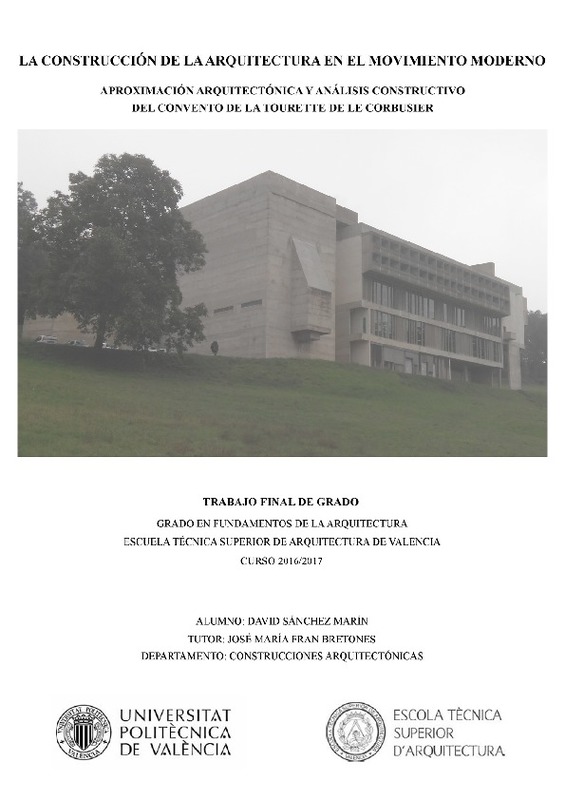JavaScript is disabled for your browser. Some features of this site may not work without it.
Buscar en RiuNet
Listar
Mi cuenta
Estadísticas
Ayuda RiuNet
Admin. UPV
La construcción de la arquitectura en el Movimiento Moderno: aproximación arquitectónica y análisis constructivo del convento de La Tourette de Le Corbusier
Mostrar el registro sencillo del ítem
Ficheros en el ítem
| dc.contributor.advisor | Fran Bretones, José Mª
|
es_ES |
| dc.contributor.author | Sánchez Marín, David
|
es_ES |
| dc.coverage.spatial | east=4.622495200000003; north=45.8193896; name=La Tourette, 69210 Éveux, França | es_ES |
| dc.date.accessioned | 2018-10-05T14:26:57Z | |
| dc.date.available | 2018-10-05T14:26:57Z | |
| dc.date.created | 2017-09-14 | |
| dc.date.issued | 2018-10-05 | es_ES |
| dc.identifier.uri | http://hdl.handle.net/10251/109750 | |
| dc.description.abstract | [ES] El convento de la Tourette es una obra única en la trayectoria de Le Corbusier. Durante mucho tiempo el arquitecto se preocupó sobre las condiciones que se debían cumplir en una vivienda, llegando a la conclusión de que éstas debían ser "máquinas para vivir". Con los proyectos de las Villas y las Unités, Le Corbusier crea iconos de viviendas individuales y colectivas y da un giro a las maneras de habitar y de construir de la época. En el proyecto de la Tourette, se encuentra de nuevo esta idea, pero con la diferencia de que en este caso, Le Corbusier debe adaptar esas ideas a la tipología monacal. El convento es por tanto, una mezcla de los conceptos de vivienda que manejaba Le Corbusier, con las exigencias y requisitos propios de un edificio religioso, algo que no se repite en toda su obra. Este trabajo se centra en los aspectos constructivos del convento de la Tourette, mostrando que suponen un punto de inflexión. Es cierto que el material que predomina en esta obra es el hormigón armado, usado en muchos de sus trabajos. No obstante, en el convento de la Tourette, aparece de muchas otras formas y tamaños, haciendo que la riqueza visual, constructiva y expresiva de este edificio crezca de una manera que no se había visto antes. Esto se debe, como se explicará en este trabajo, a la colaboración de Iannis Xenakis. Las ideas, tanto funcionales como constructivas de este ingeniero, mezcladas con la supervisión y los postulados de Le Corbusier, harán que la Tourette sea un edificio inolvidable en el cual el propio arquitecto quiso que se le enterrara tras su muerte. | es_ES |
| dc.description.abstract | [EN] The monastery of La Tourette is a unique work in Le Corbusier's trajectory. For a long time the architect was concerned about the conditions that houses needed to meet, and he reached the conclusion that they had to be conceived as "machines suitable to live in". With the projects of the Villas and the Unités, Le Corbusier created icons of individual and collective houses and changed the conventional ways of living and building of his time. In the project of La Tourette, we find these salient ideas again, albeit with the difference that in this particular instance, Le Corbusier had adapt them to the monastic typology. The Dominican priory is therefore a mixture of the concepts of housing which characterized Le Corbusier's architecture with the features and requirements of a religious building, something that would not be repeated in his entire work. This dissertation focuses on the constructive aspects of the convent of La Tourette, and it aims to show that they represent a point of inflection. Even if the material that predominates in this architectural production is reinforced concrete, which was also used in many of his buildings, in this priory it is displayed in manifold shapes and sizes, thus enhancing the building's visual, constructive and expressive richness in ways unseen before. This is due, as it will be later explained, to the collaboration of Iannis Xenakis, an engineer whose ideas, both functional and constructive, together with the supervision and principles of Le Corbusier, made of La Tourette such an unforgettable religious building that the architect himself wanted to be buried in it after his death. | es_ES |
| dc.format.extent | 103 | es_ES |
| dc.language | Español | es_ES |
| dc.publisher | Universitat Politècnica de València | es_ES |
| dc.rights | Reserva de todos los derechos | es_ES |
| dc.subject | Le Corbusier | es_ES |
| dc.subject | Iannis Xenakis | es_ES |
| dc.subject | La Tourette monastery | es_ES |
| dc.subject | Constructive analysis | es_ES |
| dc.subject | Reinforced concrete | es_ES |
| dc.subject | Undulating glass surfaces | es_ES |
| dc.subject | Convento de la Tourette | es_ES |
| dc.subject | Análisis constructivo | es_ES |
| dc.subject | Hormigón armado | es_ES |
| dc.subject | Paneles ondulatorios | es_ES |
| dc.subject.classification | CONSTRUCCIONES ARQUITECTONICAS | es_ES |
| dc.subject.other | Grado en Fundamentos de la Arquitectura-Grau en Fonaments de l'Arquitectura | es_ES |
| dc.title | La construcción de la arquitectura en el Movimiento Moderno: aproximación arquitectónica y análisis constructivo del convento de La Tourette de Le Corbusier | es_ES |
| dc.type | Proyecto/Trabajo fin de carrera/grado | es_ES |
| dc.rights.accessRights | Abierto | es_ES |
| dc.description.bibliographicCitation | Sánchez Marín, D. (2017). La construcción de la arquitectura en el Movimiento Moderno: aproximación arquitectónica y análisis constructivo del convento de La Tourette de Le Corbusier. http://hdl.handle.net/10251/109750 | es_ES |
| dc.description.accrualMethod | TFGM | es_ES |
| dc.relation.pasarela | TFGM\57631 | es_ES |
Este ítem aparece en la(s) siguiente(s) colección(ones)
-
ETSA - Trabajos académicos [4687]
Escuela Técnica Superior de Arquitectura






